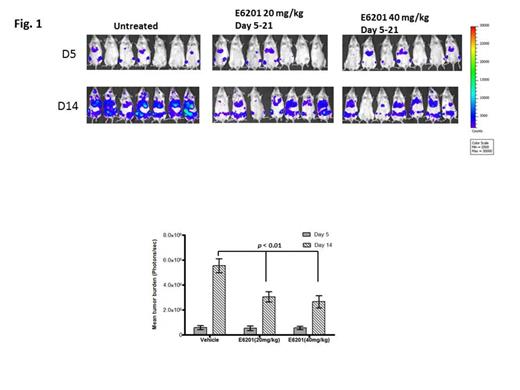Abstract
Internal tandem duplication (ITD) or point mutation of Fms-like tyrosine kinase 3 (FLT3) and N/KRAS mutations in patients with acute myeloid leukemia (AML) lead to aberrant activation of FLT3 and/or RAS–mitogen-activated protein kinase (MAPK) pathways and are associated with poor prognosis (Kottaridis et al, Leuk Lymphoma Vol. 44:905, 2003; Thiede et al, Blood Vol. 99;4326, 2002). Therapy with inhibitors targeting these pathways individually may at best result in short lasting responses in the appropriate mutational context (Borthakur et al, Haematologica Vol. 96:62, 2011; Cortes et al, Blood Vol. 114:636a, 2009). Persistent activation of MEK/ERK signaling pathway is seen in cells resistant to FLT3-ITD inhibitor sorafenib that harbor acquired point mutations of FLT3 in tyrosine kinase domains in addition to ITD mutation (Moore et al, Leukemia Vol. 26:1462, 2012).
E6201 is a MEK1/FLT3 dual inhibitor with inhibitory activity in low nanomolar concentrations against both targets. We tested E6201 against AML cells including FLT3-inhibitor resistant cells, AML patient samples and investigated its efficacy in murine AML model. E6201 inhibited cell growth and induced apoptosis in AML cells with FLT3 ITD mutations (including sorafenib-resistant cells harboring ITD plus N676D/Y842C point mutations) at nanomolar levels, and showed 600 to 1000-fold more selective activity against cells with FLT3-ITD mutations than those with FLT3-WT (IC50s 0.003µM, 0.005 and 0.002µM, respectively, in Ba/F3-ITD and FLT3-ITD mutant MOLM13 and MV4-11cells compared to 3.18µM in Ba/F3-FLT3-WT cells). In addition, OCI/AML3 cells [FLT3 and RAS wild-type(WT)], which have high basal p-ERK level and are resistant to most of chemotherapeutic drugs, were sensitive to E6201 (IC50 = 0.037µM). Consistent with its MEK1 inhibitory activity, E6201 was more active against NRAS mutation carrying OCI/AML3 and MV4-11 cells than their NRAS-WT isogenic cells. E6201-induced apoptosis appears to be p53 dependent as p53-wild-type OCI/AML3 and MOLM13 cells were significantly more sensitive compared to their paired p53-knockdown cells. EC50 of E6201 was at sub-micromolar levels in all 5 FLT3-ITD mutant primary AML samples, which included one with FLT3-ITD/RAS dual mutation.
Mechanistically, E6201 significantly suppressed p-FLT3 and p-ERK in all tested FLT3 mutant AML cell lines and p53 wild-type OCI/AML3 cells. In addition, decrease of Bcl-xL and Mcl-1 levels and increase of cleaved-caspase-3 was observed in all FLT3 mutant cell lines after treatment with E6201 for 24 hours. In conclusion, E6201 is active against AML cells with FLT3 and/or RAS mutation. A clinical trial is in development in FLT3 and/or RAS mutant AML.
Borthakur:Eisai, Inc.: Research Funding. Nomoto:Eisai, Inc.: Employment. Zhao:Eisai, Inc.: Employment.
Author notes
Asterisk with author names denotes non-ASH members.


